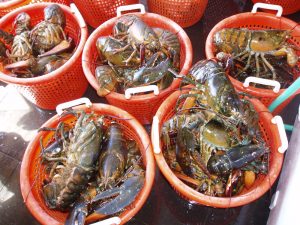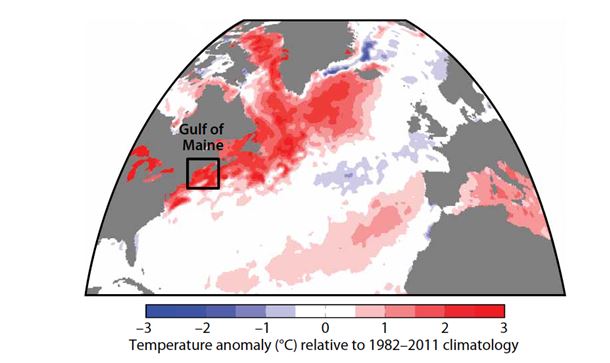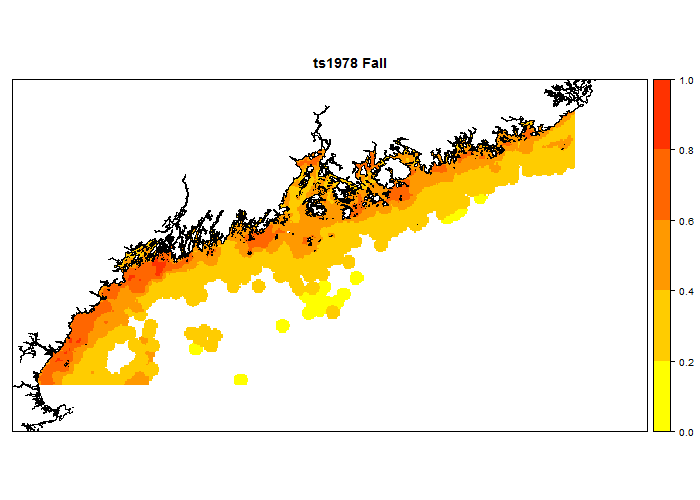Research Highlights: New England Lobster in a Changing Climate: Development of a Forecasting Tool for Habitat Suitability
By Kisei Tanaka, Graduate Student at the University of Maine Orono
Summary

Changes in water temperature and salinity resulting from climate change will likely cause changes in the size and distribution of habitats for the New England lobster. As such, projecting changes in habitat availability will be critical to effective fisheries management. To investigate the spatial and temporal variability of American lobster habitats in the Gulf of Maine and Southern New England, we developed a Habitat Suitability Index (HSI). HSI is a numerical index that can describe the quality of a given habitat for a given species, quantifying the optimal habitat conditions from 0 (unsuitable habitat) to 1 (very suitable habitat). The HSI can be used to investigate the impact of climate change on lobster habitats by quantifying the amount of suitable habitat in past, present and predicted conditions under given climate change scenarios. This project will provide habitat information to those managing the New England lobster fishery based on the expected changes in the northeastern US marine ecosystem.
Background
The American lobster (Homarus americanus) is a bottom-dwelling crustacean distributed along the northeastern coast of the United States. It is a major seafood commodity throughout the species’ range, worth over $470 million in 2013. American lobster is an ectothermic species, meaning its bodily processes are regulated by the surrounding water temperature. It prefers a thermal range between 12 and 18°C (54-64°F), and avoids temperatures above 19°C (65°F). Increasing water temperature forces lobsters to use more energy and, as water temperatures rise above 20.6°C (69°F), lobsters show various physiological stress responses.
Climate change has likely become a primary stressor to lobster populations as changes in marine ecosystems alter the availability of its suitable habitat. In September 1999, an unusual combination of high water temperature, low levels of dissolved oxygen and the toxic impacts of ammonia and sulfides in western Long Island Sound led to a massive die-off of lobsters, which effectively eliminated the $40 million lobster industry in the region. Record warm temperatures in the Gulf of Maine during 2012 did not result in population collapse, but contributed to early inshore migration and molting (Fig 1). The unusually high landings of newly recruited soft-shell lobsters in an early season overwhelmed the processing capacity and contributed to a 17 % price drop, resulting in a decline in total value of the fishery.

The water temperature in many parts of New England coastal waters has increased over the last 40 years. The 31-year time series recorded at inshore (20m depth) eastern Long Island Sound show a significant warming trend of 0.04 degrees/year. A 49-year time series for surface waters from Narragansett Bay and Rhode Island Sound show a greater warming trend at 0.05 degrees/year. The total number of days in late summer when the mean bottom water temperature remains above 20°C (68°F) has increased substantially. These warming trends were also observed in MA, including Woods Hole sea surface temperatures and bottom water temperatures from upper Buzzards Bay, as well as in eastern Long Island Sound. Warmer temperatures are likely to cause lobsters to move toward higher latitudes, deeper water or to areas cooled by tidal mixing.
Furthermore, increases in water temperature have been tied to an expansion of shell disease, which has destroyed the population south of Cape Cod and become a new threat to the lobster fishery since first being documented in the mid-1990’s. The prevalence of shell disease is positively correlated to the number of days with water temperature above 20°C (68°F). As ocean temperatures have warmed, the disease has spread northward throughout the coastal waters of New England, which may affect the lobsters in the Gulf of Maine. These incidents in Southern New England and their relationship to lobsters in the Gulf of Maine demonstrate the importance of including habitat information in fisheries management.
Method and Tentative Results
The development of a habitat modeling tool to quantify the spatial and temporal variability of suitable habitat is an important step for evaluating the consequences of climate change on American lobsters in New England. For this purpose, we developed a Habitat Suitability Index for American lobsters in the Gulf of Maine and Southern New England based on 30 years of state trawl survey data (Fig 2). The HSI model was initially developed by the US Wildlife Service to describe wildlife-habitat relationships based on limited data. HSI is a numerical index that describes the capacity of a given habitat to support a given species from 0 (unsuitable habitat) to 1 (very suitable habitat). The HSIs can be calibrated from presence/absence data, or using expert knowledge. HSI will allow us to evaluate habitat quality considering all key environmental variables for American lobster in this case, and can be combined with GIS to create habitat maps for lobster of different life history stages. Based on previous research, we have identified temperature, salinity, depth, and bottom type as important variables that may influence the habitat of American lobster. The impact of climate change on lobster habitat will be evaluated by calculating changes in the amount of suitable habitat over the past 30 years for the Gulf of Maine and Southern New England lobsters.

Next Steps
The development of HSI models will facilitate the forecasting of lobster habitat availability under a given set of hypothesized climate change scenarios and provide critical information needed for improving lobster stock assessment and management. Moreover, New England marine ecosystems are especially susceptible to abrupt shifts in ecosystem function as the stability of these systems has already been undermined by biodiversity losses due to overfishing. One of the best ways to adapt to altered marine ecosystems brought on by a changing climate is to improve our ability to forecast the dynamics of populations and ecosystems.
Note:
This study is part of the NSF’s Coastal SEES (Science, Engineering and Education for Sustainability) Initiative and a continuation of ongoing model development work in Dr. Yong Chen’s Laboratory at the University of Maine in collaboration with NOAA, ASMFC and Maine Department of Marine Resources (DMR) to improve lobster stock assessment.
